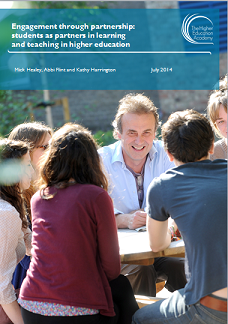Engagement through partnership

 The recently published Higher Education Academy (HEA) report by Mick Healey, Abbi Flint and Kathy Harrington entitled Engagement through partnership: students as partners in learning and teaching in higher education (York: HEA, 2014) makes for very interesting reading.
The recently published Higher Education Academy (HEA) report by Mick Healey, Abbi Flint and Kathy Harrington entitled Engagement through partnership: students as partners in learning and teaching in higher education (York: HEA, 2014) makes for very interesting reading.
In declaring that engaging “students and staff effectively as partners in learning and teaching is arguably one of the most important issues” facing 21st century Higher Education (HE), this report makes various references to the concept and case for partnership, the ability to develop this through learning communities, etc., as well as various concrete mechanisms through which this might be aided (including student charters, peer support, etc.).
Of particular interest are the arguments made in favour of involving students in curriculum and assessment design, with case studies offered under the following four headings:
- learning, teaching and assessment;
- subject-based research and enquiry;
- scholarship of teaching and learning; and
- curriculum design and pedagogic consultancy.
In sum, as the HEA points out: “Drawing together extensive UK and international scholarship and research to propose a new conceptual model for exploring the variety of understandings of students as partners in learning and teaching, this publication:
- examines the motivations and rationales for staff and students engaging in partnership;
- offers a pedagogical case for partnership;
- identifies examples of strategic and sustainable practices of engaging students as partners in learning and teaching;
- outlines how the development of partnership learning communities may guide and sustain practice in this area;
- identifies tensions and challenges to partnership;
- offers suggestions to individuals and institutions for addressing challenges and future work.”
It certainly gives us something worth thinking about, as well as acting upon, as we consider the potential inherent, as well as the progress already made, in terms of ‘students as partners’ in their learning and teaching. As the report points out, for this to be most effective and for it to reflect the evolving nature of HE and the relationships within it, this will require institution-wide approaches involving staff operating in academic departments, professional services, etc., working in active collaboration with both students and students’ unions.